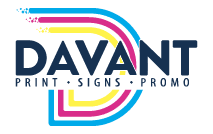Photo Credit: https://www.pexels.com/photo/san-diego-apparel-america-s-finest-city-176837/
Brand logos are everywhere. Not a day goes by that you’re not bombarded by advertisements, social media posts, and daily email marketing tactics. But what’s in those tiny little designs that makes them so unique? Perhaps it’s the product or service you associate with each logo. Or maybe it’s the little figure the brand has interwoven into the design.
What if we told you that the most important fact of any logo comes to mind is the color? That’s right! Your brain holds onto each image because of the color and the feelings or emotions associated with them. Those triggers are precisely what marketing gurus are after so they can better target their ads, emails, and social media posts to their best client: You.
At Davant, we help customers with their branding and logo designs, and it always starts with the color. Your brand’s color can make or break it, which is why it requires careful thought and consideration. To help you along in the process, we thought we’d provide you with a breakdown of the psychology of colors and how to choose the right one for your brand and logo.
What is Color Psychology?
Color psychology is one of the main pillars of branding and marketing. Corporations that have taken the time to understand color and human behavior have really cashed in. When you study how specific colors influence human behavior, you can steer your branding in the right direction. The right color can attract the right customer, while the wrong color can do just the opposite.
What Does Each Color Mean?
Logo and brand design thinking are both strategic exercises that any startup business goes through. There’s no one-size-fits-all solution when selecting the right color for your product or service. When thinking about your logo color, keep in mind the first impression you want to give customers and how you want to be remembered. This direction will help lead you to the right color for your marketing assets.
If you’re still unsure where to begin, here are the primary colors to consider and what they mean:
- Red – Red is a bold color and is often associated with power, strength, and passion. It’s perhaps one of the most controversial colors on the color wheel, but when used correctly, it can really have a positive impact on your logo and brand.
- Blue – If you’re looking for a calming tone to your logo, blue is the way to go. Consumers associate blue with being in control, logical, honest, intelligent, free, and confident. Using blue in your logo will help your brand establish trust and loyalty, especially among American and European consumers.
- Yellow – We all associate yellow with being playful and sunny. You might even instantly think of the golden arches of McDonald’s. Either way, using yellow or a hue of gold in your branding colors tells your customers that your business is warm and inviting. However, darker shades can also be associated with luxury branding (Chevrolet, Cadbury, and Gucci).
- Orange – Many current startups are leaning towards using orange in their branding and logo designs. Consumers tend to get a funny, energetic, warm, and youthful vibe from companies that choose orange in their color scheme. If you have a product or service that caters to younger people, consider a logo using a hue of orange.
Choosing the Right Color
Selecting the right color for your brand doesn’t have to be overwhelming. At Davant, we can help guide you through the process, or you can keep these two quick tips in mind to navigate the selection challenges.
- Start with a black and white version of your logo. Having a blank slate can help you mix and match colors. Slowly experiment with adding a shade or two, but if your logo looks good in black and white, you might want to just leave it. Plenty of reputable brands, such as Nike, Adidas, and Apple, leave their markings in black and white. This works well for them, but it still allows for design flexibility when they want to add a color for specific campaigns.
- Keep a color wheel handy. Using a color wheel will help you select between analog and complementary colors. Picking up to three analog colors can create a cohesive look to your brand and logo. In contrast, complementary colors offer a nice contrast. The clash of colors is attention-grabbing, but if you’re in an industry that requires calm and soothing aesthetics, stick to analog colors.
Print Your Materials at Davant
When it comes time to put your logo and brand to print, turn to the team at Davant for all of your marketing materials. We can help supply you with flyers, banners, apparel, and more. Contact us at (317) 849-6565.

